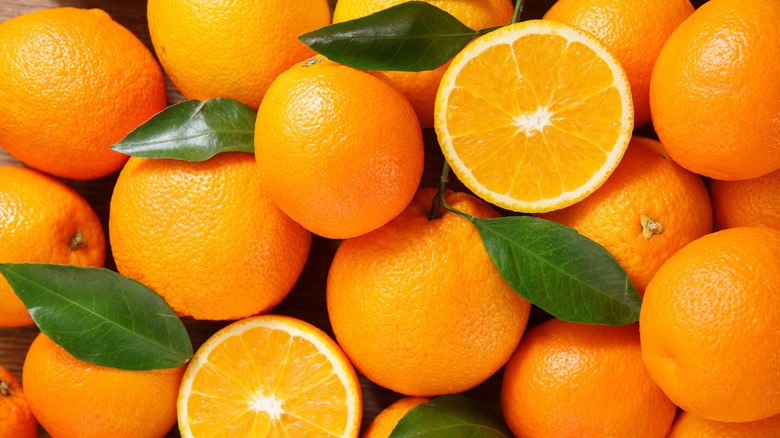Why You Shouldn't Rely On Color When Picking Out Oranges
Delivering a citrus surge, oranges seem to be popular all year long, especially during cold and flu season. Since they contain many nutrients, antioxidants, and vitamin C, they have become the poster child for health. In fact, a single orange can provide 92% of your daily vitamin C, which supports the immune system, increases iron absorption, and even boosts collagen production (via Healthline). If you're inspired to grab some oranges on your next grocery run, make sure that you choose wisely — especially when it comes to color.
Citrus sinensis, as it's known by its scientific name, is actually a hybrid of the large, sour pomelo and the more petite, floral-tasting mandarin. Dating back to the 6th century in China, the orange was first enjoyed by nobility, explains The New Yorker. However, years of diffusion have led the citrus to grow in popularity.
Even though the fruit is now produced worldwide, including in the U.S., Statista shares that Brazil is the top orange producer in the world, yielding close to 15 million metric tons of citrus between 2020 and 2021. While consumer demand for citrus is strong, many are unaware of how to shop for the best oranges. Should we pay attention to the color of the peel, or is this guiding us in the wrong direction?
Color doesn't mean quality
It's wise to think about seasonality before you set foot in a grocery. Depending on which type of citrus you're looking for, some may be riper than others. Generally speaking, Modern Farmer outlines that most oranges are available in the U.S. year-round, but peak during winter months.
When faced with a mountain of orange, know that considering color is usually not the best way to determine quality. Fine Dining Lovers reports that with over 400 varieties, every cultivar of orange can have different characteristics and shades of peel — from carrot-colored navel oranges to salmon-hued blood oranges and emerald bergamot oranges. Some varieties, like the Valencia, can even turn green after ripening, notes Harvest to Table. Likewise, scratches or brown spots can indicate the effects of harvesting or growing in warm climates rather than spoilage.
Instead of using your sense of sight, rely on your sense of touch to find the ripest orange. Bon Appétit suggests choosing oranges that feel heavy despite their size. A delicate squeeze to make sure they aren't mushy can also help determine whether you've found a ripe fruit.
Lastly, remember that oranges will keep at room temperature for up to 10 days, but the FDA notes that storing them in the fridge can extend their shelf life for about 3 weeks.

